
Features
New Varieties
New and notable perennials for this side of the border
Breeders share their top perennial varieties for 2021, tailored for the Canadian market.
November 24, 2020 By Greta Chiu
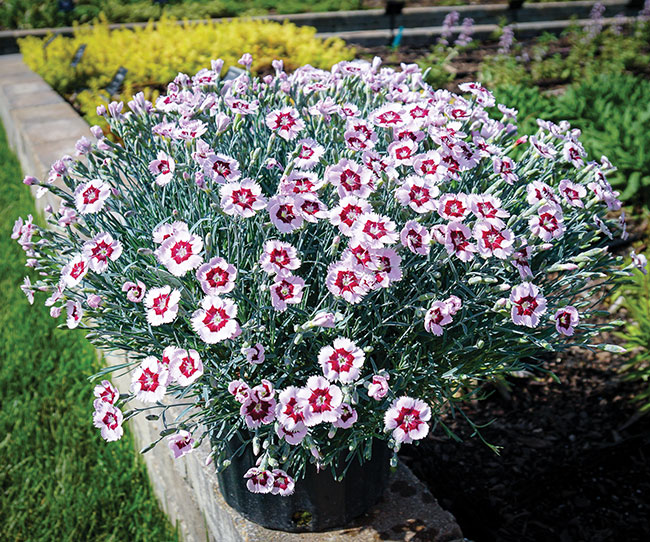 Dianthus Mountain Frost
Dianthus Mountain Frost When it comes to growing perennials in Canada, the first question is – can it survive?
To reach the Canadian market, breeders are trialling new perennial varieties in areas just south of B.C. up to Winnipeg, Man. – and for more than one season – to ensure consumer and grower satisfaction.
In addition to surviving temperature extremes, other perennial trends identified by breeders included first-year-flowering, longer bloom periods and the need to show off some colour at retail. Being pollinator-friendly might be a well-known attribute, but reminders are still a must.
What exciting genetics are in store for 2021? Seed breeders shared their favourite new and notable perennial selections, along with thoughts for the coming year, all catered towards the Canadian market.
Darwin Perennials, Kieft Seed
When selecting perennials, there are a number of advantages to using first-year flowering varieties. “Breeders are working to take the cold treatment requirements out of perennials so growers are able to achieve full flowering potential the first year,” says Chris Fifo, product representative at Darwin Perennials and Kieft Seed. “Not only does it have the trickle-down effect of helping growers with scheduling,” it also gets colour on perennials at retail. “Because that’s what consumers want – colour!”
Fifo has also noticed growing interest in summer to fall programs over the past few years and offers an alternative to the classic mum.
“An echinacea in full flower, in a container, in the fall will blow away any mum on any day and will give the customer much more value,” he says. “It’s going to last longer than a potted mum, long past frost, and they’re going to get a much better return on investment.”
For years, perennial breeding seemed to be headed towards more compact plants. “We wanted to fit more onto a rack in the garden centre [or] cram more into a particular space in the garden.” But for some crops, larger sizes are back on trend again, particularly for those geared towards landscape performance
1. Dianthus Mountain Frost – Ruby Glitter, Ruby Snow (Darwin Perennials): Differing from the hundreds of dianthus on the market, Mountain Frost’s breeding program has focused on landscape performance. Flowering rapidly through the summer with a second flush in the fall, Fifo says they tolerate heat, humidity and summer rains without “melting out in the middle.” A grower of more than 30 years, Fifo says he was never taken by dianthus until he saw Mountain Frost in landscape trials. “They’ve absolutely blown me away as far as performance goes. I have not seen any others that will spread, bulk up and fill out the landscape like these do.” With new additions Ruby Glitter and Ruby Snow (pictured), this collection offers nine different colours. Though these are first-year flowering, growers will have the greatest flower power and success from a fall-planted container. Zone 4.
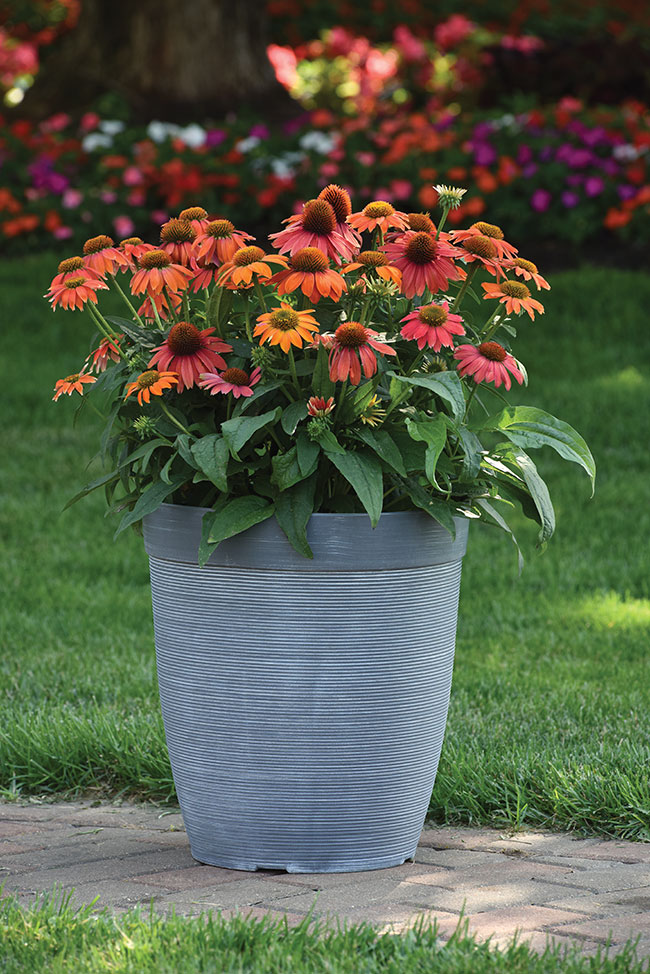 2. Artisan Echinacea (Kieft Seed): The first collection of F1 hybrid echinacea from seed on the market, Artisan took breeders more than 10 years to perfect. Because it’s F1, “it offers better consistency, uniformity, branching and plant height,” explains Fifo, especially when compared to open-pollinated seed varieties. First-year flowering and highly consistent among bench runs, cultural requirements are identical to the PowWow echinacea series. Artisan debuts in two colours, Red Ombre and Soft Orange, with five more to come in the next few years. Its breeder, Dr. Jianping Ren, won the 2020 All-America Selections Breeder’s Cup in recognition of her influential work, including PanAmerican Seeds’ Wave petunias. Artisan blooms early to mid-summer in landscape and is suitable for summer to fall programs. Zone 4.
2. Artisan Echinacea (Kieft Seed): The first collection of F1 hybrid echinacea from seed on the market, Artisan took breeders more than 10 years to perfect. Because it’s F1, “it offers better consistency, uniformity, branching and plant height,” explains Fifo, especially when compared to open-pollinated seed varieties. First-year flowering and highly consistent among bench runs, cultural requirements are identical to the PowWow echinacea series. Artisan debuts in two colours, Red Ombre and Soft Orange, with five more to come in the next few years. Its breeder, Dr. Jianping Ren, won the 2020 All-America Selections Breeder’s Cup in recognition of her influential work, including PanAmerican Seeds’ Wave petunias. Artisan blooms early to mid-summer in landscape and is suitable for summer to fall programs. Zone 4.
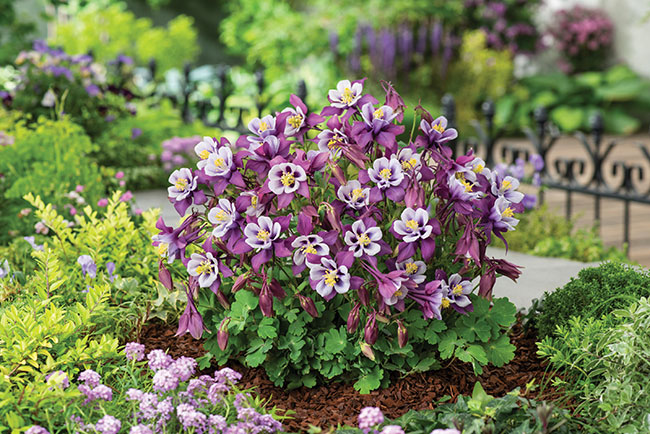 3. Early Bird Aquilegia (Kieft Seed): Minimizing the length and intensity of cold treatments typically needed for aquilegia, Early Bird needs just five weeks at 12.8 ºC or lower to maximize flowering potential, making them easier to schedule. “There is a very tight, 10-day window for flowering among the colours,” adds Fifo, so growers can bench run with ease. With stalks reaching just 12” high, the series may be compact but develops surprisingly large, upright facing flowers. “We have some novel colours you will not see in any other aquilegia,” he says, singling out purple-white and purple-yellow as his favourites among the eight colours and mix available. A springtime crop, it’s among the first to flower in landscape and lasts for about six weeks. Zone 3.
3. Early Bird Aquilegia (Kieft Seed): Minimizing the length and intensity of cold treatments typically needed for aquilegia, Early Bird needs just five weeks at 12.8 ºC or lower to maximize flowering potential, making them easier to schedule. “There is a very tight, 10-day window for flowering among the colours,” adds Fifo, so growers can bench run with ease. With stalks reaching just 12” high, the series may be compact but develops surprisingly large, upright facing flowers. “We have some novel colours you will not see in any other aquilegia,” he says, singling out purple-white and purple-yellow as his favourites among the eight colours and mix available. A springtime crop, it’s among the first to flower in landscape and lasts for about six weeks. Zone 3.
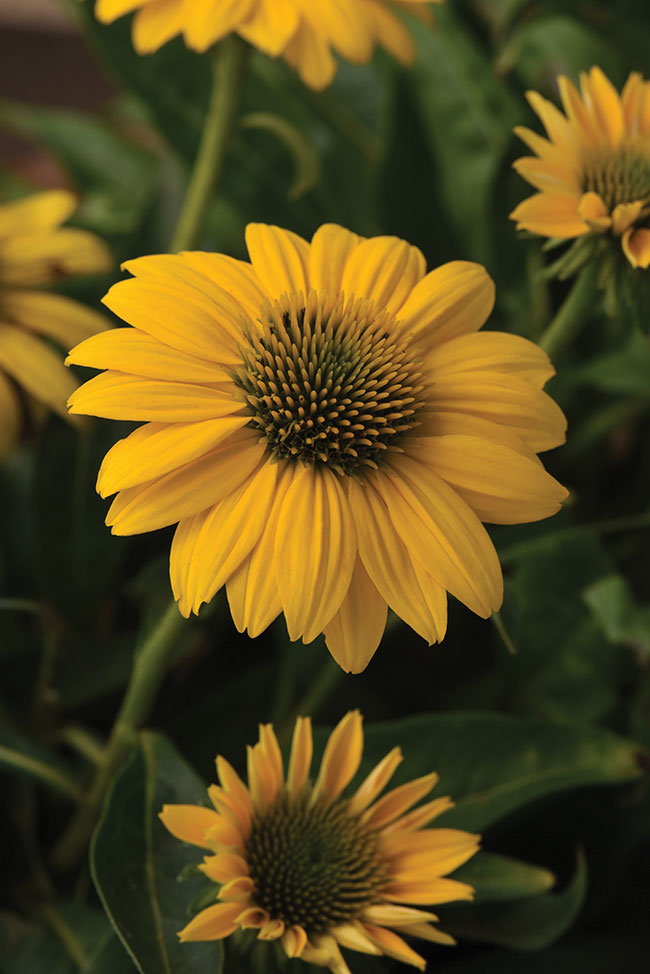 4. Echinacea Sombrero Poco (Darwin Perennials): With the original Echinacea Sombrero series now grown to 14 different colours, Darwin started a spin-off series called ‘Poco’ meaning small. “These very compact echinacea have a finished height of 16” tops, and that’s second or third year,” says Fifo. The first-year flowering series debuts with the bold, non-fading intensity of Poco Yellow. “The oldest flowers are just as bright as the newest flowers until they start to turn brown from age,” explains Fifo. In fact, the breeding team has identified the gene responsible for its non-fading trait and applied for a utility patent. An early to mid-summer landscape bloomer, Poco is suitable for summer to fall programs. Zone 4.
4. Echinacea Sombrero Poco (Darwin Perennials): With the original Echinacea Sombrero series now grown to 14 different colours, Darwin started a spin-off series called ‘Poco’ meaning small. “These very compact echinacea have a finished height of 16” tops, and that’s second or third year,” says Fifo. The first-year flowering series debuts with the bold, non-fading intensity of Poco Yellow. “The oldest flowers are just as bright as the newest flowers until they start to turn brown from age,” explains Fifo. In fact, the breeding team has identified the gene responsible for its non-fading trait and applied for a utility patent. An early to mid-summer landscape bloomer, Poco is suitable for summer to fall programs. Zone 4.
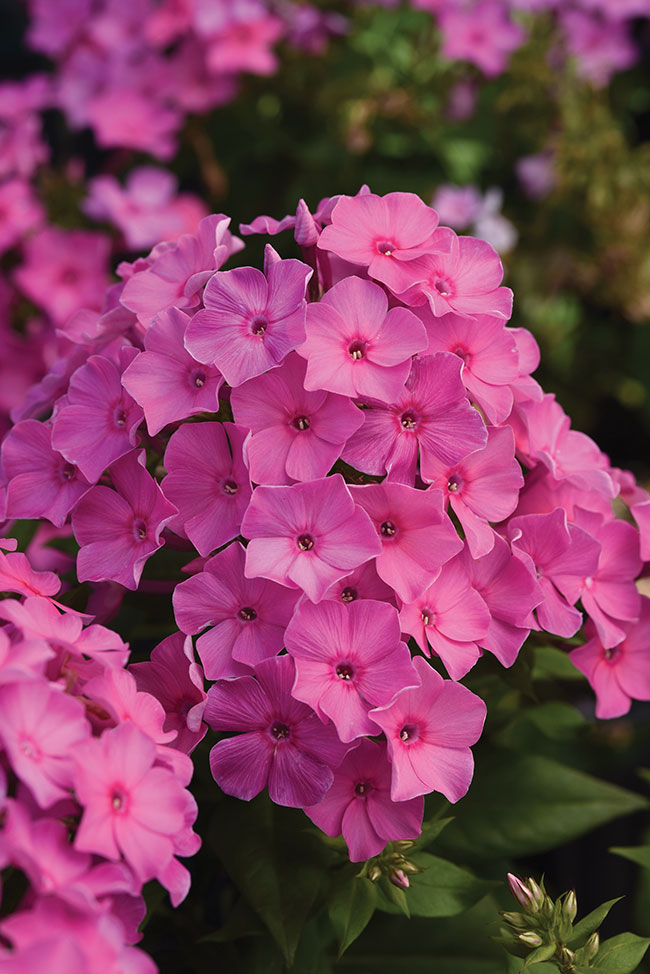 5. Super Ka-Pow Phlox (Darwin Perennials): This Phlox paniculata is Fifo’s favourite on this list. A supersized version of the more compact Ka-Pow series introduced a couple years ago, new Super Ka-Pow reaches upwards of 20 to 24” tall – perfect for 1.5 to 2-gallon containers. With tall phlox typically more susceptible to mildew, breeding on Super Ka-Pow has focused on tolerance to the disease with tremendous results. It’s also free-branching with supersized flowers, and a supersized habit, says Fifo. “Phlox breeding has been getting earlier and earlier. You’re seeing them flower around the end of June in landscape now,” which is where Super Ka-Pow fits in. Launching in white, pink, lavender and fuschia, the latter is Fifo’s favourite. Zone 4.
5. Super Ka-Pow Phlox (Darwin Perennials): This Phlox paniculata is Fifo’s favourite on this list. A supersized version of the more compact Ka-Pow series introduced a couple years ago, new Super Ka-Pow reaches upwards of 20 to 24” tall – perfect for 1.5 to 2-gallon containers. With tall phlox typically more susceptible to mildew, breeding on Super Ka-Pow has focused on tolerance to the disease with tremendous results. It’s also free-branching with supersized flowers, and a supersized habit, says Fifo. “Phlox breeding has been getting earlier and earlier. You’re seeing them flower around the end of June in landscape now,” which is where Super Ka-Pow fits in. Launching in white, pink, lavender and fuschia, the latter is Fifo’s favourite. Zone 4.
Syngenta Flowers
With limited greenhouse space, first-year flowering options can be a good choice for many, but overwintering still has its place. “Some growers prefer overwintering perennials, even if it may be first-year flowering,” says Steffi Hugo, perennial product manager at Syngenta Flowers. She adds that the practice can help fill out different sized containers depending on growers’ needs.
With perennials, Hugo emphasizes versatility and finding the right fit. Her top perennial recommendations include some that are early, in-between and end-of-season flowering, giving growers multiple opportunities to make changes, little by little.
“You can see a dozen different trial places and pictures, but your site is the one where it needs to work,” she says, drawing from her experience as a former grower. “You’ve got to see it in your own circumstances and your own environment, more than anything.”
Other trends she’s noticed include a growing emphasis on heat- and cold-tolerant traits, particularly with the unpredictability of the climate. On the retail side, Hugo urges garden centres to show the many benefits of perennials, particularly for pollinator, environment and human health.
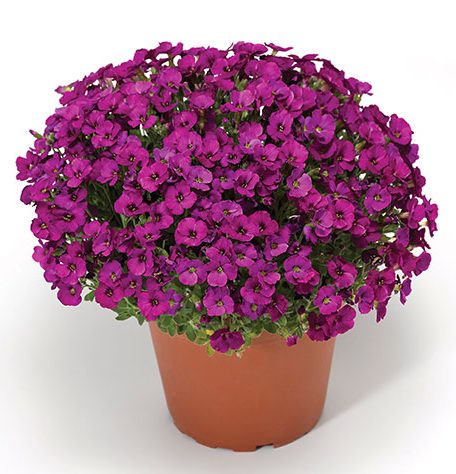 6. Aubrieta hybrida Glacier: The newest addition to Syngenta’s Aubrieta portfolio, the Glacier series flowers in early spring about two to three weeks later than Aubrieta Axcent, lending versatility to a grower’s program. Its compact, mounding habit makes it perfect for quarts and gallons. “This is one of those items that needs a solid vernalization period to build up some bulk,” says Hugo. “Start this late summer to give it some stability for that overwintering period.” The Glacier series debuts in three colours: Red, Violet and Sky Blue. Zone 6.
6. Aubrieta hybrida Glacier: The newest addition to Syngenta’s Aubrieta portfolio, the Glacier series flowers in early spring about two to three weeks later than Aubrieta Axcent, lending versatility to a grower’s program. Its compact, mounding habit makes it perfect for quarts and gallons. “This is one of those items that needs a solid vernalization period to build up some bulk,” says Hugo. “Start this late summer to give it some stability for that overwintering period.” The Glacier series debuts in three colours: Red, Violet and Sky Blue. Zone 6.
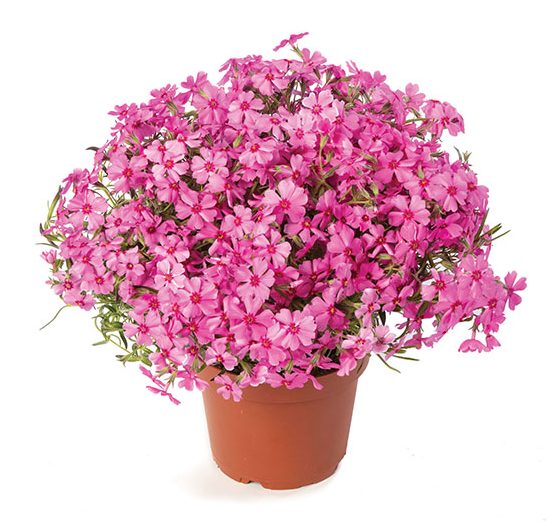 7. Phlox subulata GoldiPhlox: “Everybody loves a subulata phlox – it’s one of those perennial staples in many garden programs,” says Hugo. Though there are some ‘oldies but goodies’ still on the market, Hugo says GoldiPhlox is a much needed upgrade from older genetics and has delivered uniform flowering across colours in multiple trials. “Our top pick is Cherry, with its bright, vibrant deep pink colour.” Best suited for quarts and gallons, this versatile series fits into container gardens and perennial landscapes. Vernalization required, GoldiPhlox should be started late summer to early fall for early spring flowering. Zone 3.
7. Phlox subulata GoldiPhlox: “Everybody loves a subulata phlox – it’s one of those perennial staples in many garden programs,” says Hugo. Though there are some ‘oldies but goodies’ still on the market, Hugo says GoldiPhlox is a much needed upgrade from older genetics and has delivered uniform flowering across colours in multiple trials. “Our top pick is Cherry, with its bright, vibrant deep pink colour.” Best suited for quarts and gallons, this versatile series fits into container gardens and perennial landscapes. Vernalization required, GoldiPhlox should be started late summer to early fall for early spring flowering. Zone 3.
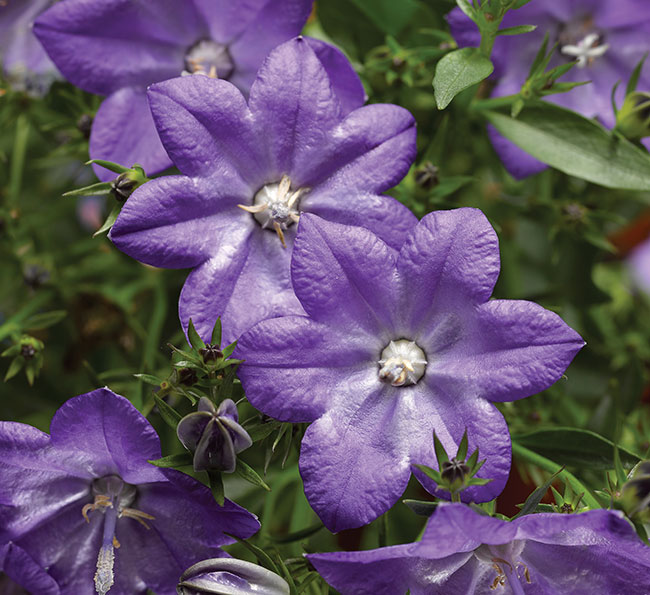 8. Campanula Cariboo Forte Blue: The results of interspecific breeding, this first-year flowering campanula boasts earlier blooms with a strong, full habit. Suitable for quarts but with a preference for gallons, the variety lives up to the ‘Forte’ in its name with a fuller habit, stronger stand and large, showy flowers that campanula is known for. This selection is accentuated by its vibrant deep blue colouring and has displayed what Hugo describes as ‘true perennial strength’ in garden trials across the U.S. To satisfy its need for an obligate long-day response, Hugo suggests starting on short days towards the end of the year, then transitioning to long days. Zone 5.
8. Campanula Cariboo Forte Blue: The results of interspecific breeding, this first-year flowering campanula boasts earlier blooms with a strong, full habit. Suitable for quarts but with a preference for gallons, the variety lives up to the ‘Forte’ in its name with a fuller habit, stronger stand and large, showy flowers that campanula is known for. This selection is accentuated by its vibrant deep blue colouring and has displayed what Hugo describes as ‘true perennial strength’ in garden trials across the U.S. To satisfy its need for an obligate long-day response, Hugo suggests starting on short days towards the end of the year, then transitioning to long days. Zone 5.
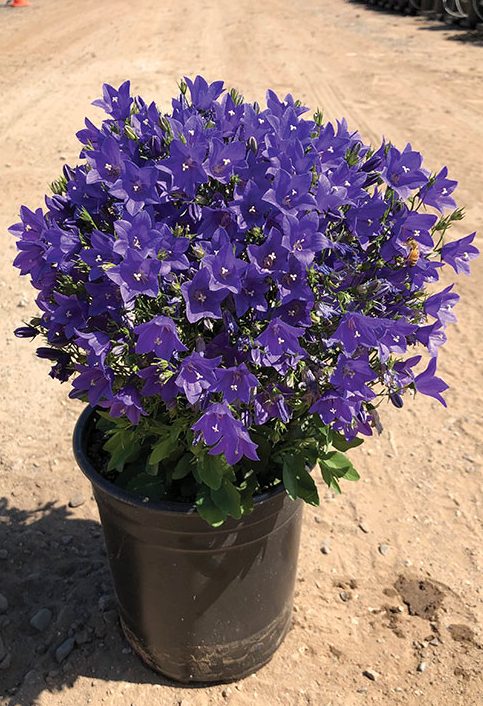 9. Campanula Spring Bell 2.0 Dark Blue: “The dark blue is very vibrant, very showy,” says Hugo of the latest addition to the Spring Bell 2.0 series. Created from interspecific breeding, Dark Blue offers a tidy, mounded habit with a multitude of blooms. Ideal for small to medium-sized containers, it’s a good option for growers looking to extend their range of sizes in campanula offerings. “[It’s] not only for perennial garden performance, but for pot crops as well,” she says, highlighting its versatility. Spring Bell 2.0 Dark Blue is first-year flowering, mirroring the timing of Cariboo Forte. Zone 5.
9. Campanula Spring Bell 2.0 Dark Blue: “The dark blue is very vibrant, very showy,” says Hugo of the latest addition to the Spring Bell 2.0 series. Created from interspecific breeding, Dark Blue offers a tidy, mounded habit with a multitude of blooms. Ideal for small to medium-sized containers, it’s a good option for growers looking to extend their range of sizes in campanula offerings. “[It’s] not only for perennial garden performance, but for pot crops as well,” she says, highlighting its versatility. Spring Bell 2.0 Dark Blue is first-year flowering, mirroring the timing of Cariboo Forte. Zone 5.
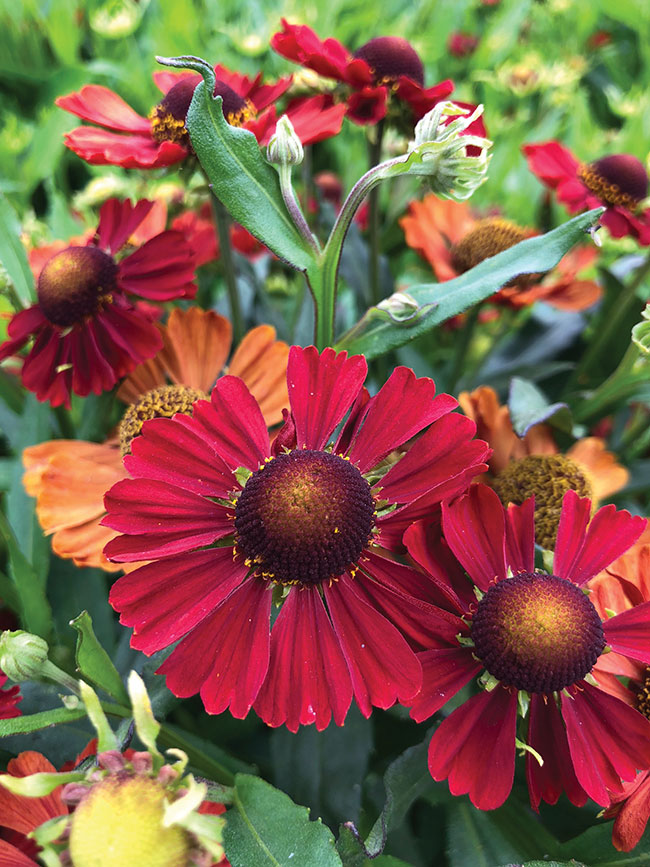 10. Helenium autumnale HayDay: “These are exciting new genetics,” says Hugo. “Everyone knows the classic prairie wildflower look, [but] HayDay forms a contained, well-mounded habit…great for production.” The new series debuts in five festive colours including classics Red, Orange and Yellow, as well as two bicolours Golden and Red, bringing warmth to the landscape. Its upright, mounded habit is well-suited for gallons and boasts a dense, branching habit. “It produces a multitude of blooms, which in turn [become] super pollinator attractants with those bright and vibrant colours,” says Hugo. “This is a really great addition to anyone’s perennial program.” First-year flowering, HayDay blooms from summer into fall. Zone 5.
10. Helenium autumnale HayDay: “These are exciting new genetics,” says Hugo. “Everyone knows the classic prairie wildflower look, [but] HayDay forms a contained, well-mounded habit…great for production.” The new series debuts in five festive colours including classics Red, Orange and Yellow, as well as two bicolours Golden and Red, bringing warmth to the landscape. Its upright, mounded habit is well-suited for gallons and boasts a dense, branching habit. “It produces a multitude of blooms, which in turn [become] super pollinator attractants with those bright and vibrant colours,” says Hugo. “This is a really great addition to anyone’s perennial program.” First-year flowering, HayDay blooms from summer into fall. Zone 5.
Dümmen Orange
“People are looking for things that have a longer shelf-life,” says Jeff LaCourse, perennial product support for Dümmen Orange, North America. New genetics are offering longer bloom periods in a greater variety of colours. “We’re finally seeing the movement away from old grandmother plants in the garden, not necessarily away from that type of flower, but to new genetics that perform better with longer satisfaction.”
For LaCourse, seeing varieties that thrive in a multitude of zones brings immense joy, particularly when they flourish from Miami up to Winnipeg and on almost every continent. “We’re excited for the consumer when you know you have something that will return. It’s not going to be planted like an annual and not be there the next year.”
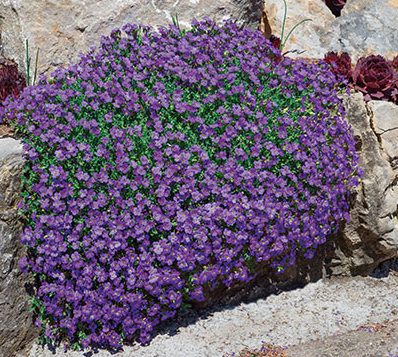 11. Aubrieta Rock On Purple: Bred for the early spring season, Rock On Purple is the latest addition to this early flowering series of Aubrieta from Dümmen Orange and a member of the breeder’s alpine rock gardening umbrella ‘Fleur de Rock.’ It’s hardy, too, successfully overwintering in trials held in Portage la Prairie, 75 km west of Winnipeg, Man. “We’re extremely excited because most of the Aubrietas on the market do not overwinter,” says LaCourse. In contrast to the short-flowering windows of most Aubrietas, in-ground trials in Washington state recorded long flowering periods that extended until June and handled moisture very well. “Pansy culture fits Aubrietas extremely well, so you want to grow them cool, not freezing at first…but they will bulk up through the fall.” Most growers transplant in September. Expect to see first flowers around mid- to late-February in B.C., mid-April in the Prairies. Zone 3
11. Aubrieta Rock On Purple: Bred for the early spring season, Rock On Purple is the latest addition to this early flowering series of Aubrieta from Dümmen Orange and a member of the breeder’s alpine rock gardening umbrella ‘Fleur de Rock.’ It’s hardy, too, successfully overwintering in trials held in Portage la Prairie, 75 km west of Winnipeg, Man. “We’re extremely excited because most of the Aubrietas on the market do not overwinter,” says LaCourse. In contrast to the short-flowering windows of most Aubrietas, in-ground trials in Washington state recorded long flowering periods that extended until June and handled moisture very well. “Pansy culture fits Aubrietas extremely well, so you want to grow them cool, not freezing at first…but they will bulk up through the fall.” Most growers transplant in September. Expect to see first flowers around mid- to late-February in B.C., mid-April in the Prairies. Zone 3
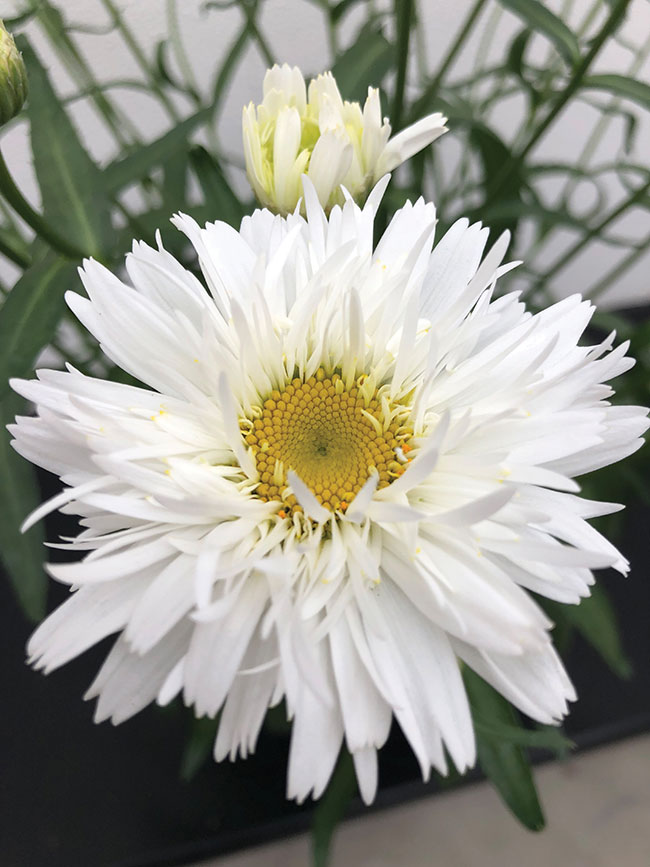 12. Leucanthemum Sweet Daisy Rebecca: Dümmen Orange’s Sweet Daisy collection houses a number of varieties with a wide array of traits, varying in size and habit. Rebecca is their newest addition – a fully double frill flower, differing from the traditional daisy-type petal. “The plant has a round, mounding habit, almost like a garden mum,” says LaCourse. Not only does it boast large double blooms, but the plant ‘buries the dead,’ hiding older flowers and lengthening its shelf-life at retail. “Double flowers tend to not abort and drop off, so…that’s an extremely good trait for fully double-type Shasta.” Flowering by mid-June at the latest, Rebecca’s long blooming period continues all the way to Fall. The chilling requirement is very low, allowing for spring transplant. Liners should be planted by the first of March to hit the June window. Zone 4.
12. Leucanthemum Sweet Daisy Rebecca: Dümmen Orange’s Sweet Daisy collection houses a number of varieties with a wide array of traits, varying in size and habit. Rebecca is their newest addition – a fully double frill flower, differing from the traditional daisy-type petal. “The plant has a round, mounding habit, almost like a garden mum,” says LaCourse. Not only does it boast large double blooms, but the plant ‘buries the dead,’ hiding older flowers and lengthening its shelf-life at retail. “Double flowers tend to not abort and drop off, so…that’s an extremely good trait for fully double-type Shasta.” Flowering by mid-June at the latest, Rebecca’s long blooming period continues all the way to Fall. The chilling requirement is very low, allowing for spring transplant. Liners should be planted by the first of March to hit the June window. Zone 4.
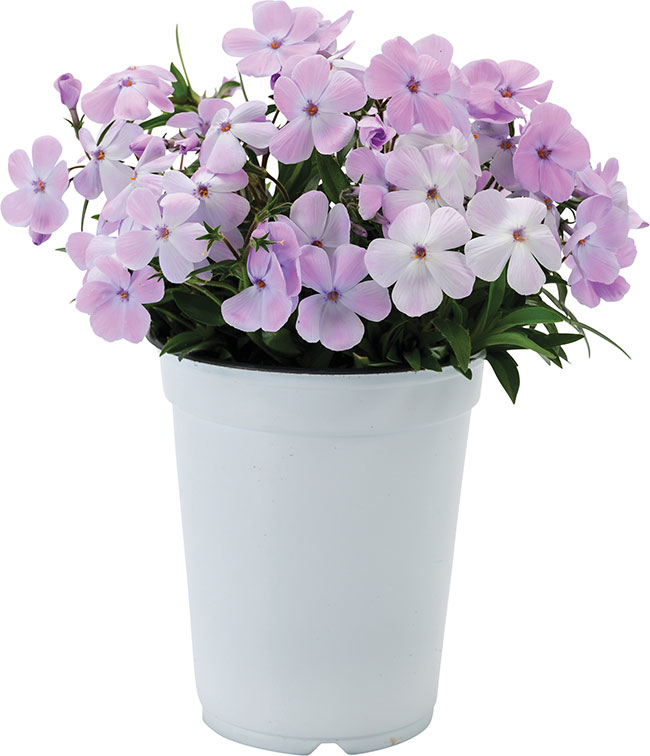 13. Phlox Woodlander Series: Debuting in lilac, pink, rose and white, this breakthrough series is bred from an interspecific cross and named for its extreme versatility in growing environments. “There is nothing like it on the market,” says LaCourse. “It can be grown in full sun or as an understory beneath a tree and still flower, which is highly unusual for phlox.” Woodlanders tend to take on a mounding habit in colder environments, but lean toward a trailing habit in areas with less light. This series blooms just as subulata fades, filling a gap between earlier and later flowering phlox. LaCourse recommends pansy culture for a shorter crop time. July cuttings can be transplanted in September for bulking in a cold frame environment. Zone 3.
13. Phlox Woodlander Series: Debuting in lilac, pink, rose and white, this breakthrough series is bred from an interspecific cross and named for its extreme versatility in growing environments. “There is nothing like it on the market,” says LaCourse. “It can be grown in full sun or as an understory beneath a tree and still flower, which is highly unusual for phlox.” Woodlanders tend to take on a mounding habit in colder environments, but lean toward a trailing habit in areas with less light. This series blooms just as subulata fades, filling a gap between earlier and later flowering phlox. LaCourse recommends pansy culture for a shorter crop time. July cuttings can be transplanted in September for bulking in a cold frame environment. Zone 3.
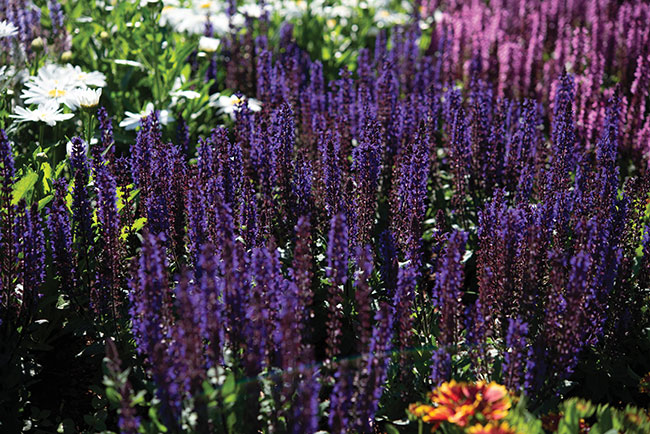
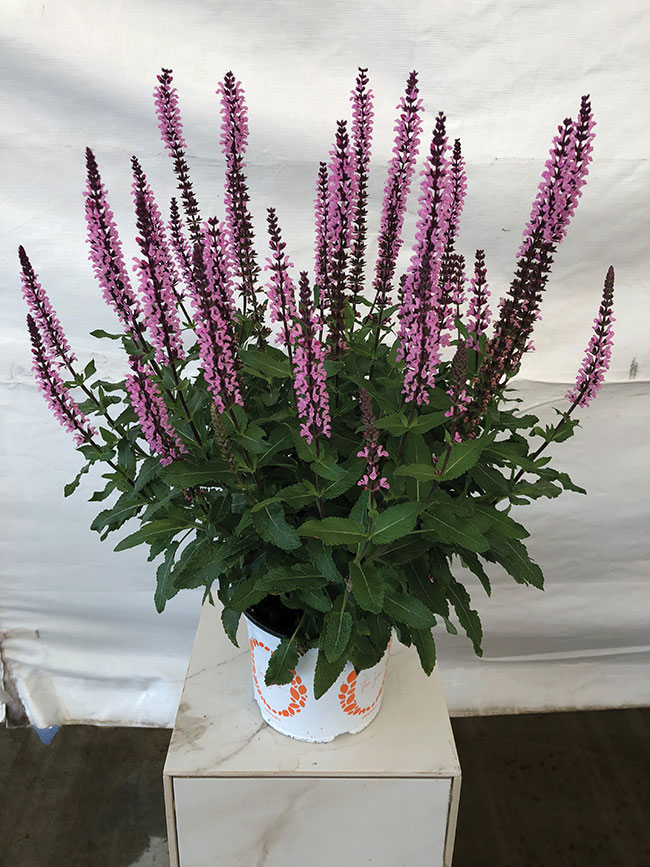
14. Salvia Midnight Series: New series Salvia Midnight debuts in two colours: Purple and Rose. It has caught a lot of attention in Europe, says LaCourse. “The two salvias are brother and sister, meaning they’re almost identical except in colour.” The pair have the same habit and flowering window, among other traits, making them ideal for planting together. The extremely dark, almost black flower stems intensify the rose and purple hues of the flowers and provide beautiful colour even when the blooms start to abort. “[Because] the calyx on the flower stalk has a purple tint, looking at the plant from a distance, you would think it’s still in flower. It’s a wonderful trait to have in a salvia.” Even without pinching, the Midnight series branches profusely, translating into dense flowers. “It can be traditionally planted in the fall like the Aubrieta, or planted in the spring like the Shasta,” explains LaCourse. Offering a long flowering window of six to eight weeks, deadheading is required after that point to encourage continued blooms. Perfect as a duo in an 8” or gallon container. Zone 3.
Terra Nova Nurseries
“Our breeding philosophy is, this plant has to have value to everyone who touches it, whether it’s the wholesale grower, the retailer, [or] the consumer,” says Chuck Pavlich, director of new product development at Terra Nova Nurseries. His top perennial choices for Canada are all first-year flowering, ensuring a quick finish with lasting quality. Like all Terra Nova varieties, they’re bred without genetic modification or irradiation.
“COVID has done the horticultural industry a favour,” he says. “We’ve hooked people onto horticulture, and the houseplant market has exploded.” Looking at the rising prices of houseplants at retail, it may be time for the industry to revisit their revenue structure. “Consumers don’t think of us as a place to get cheap materials. If it’s a great plant, they’ll pay for it.”
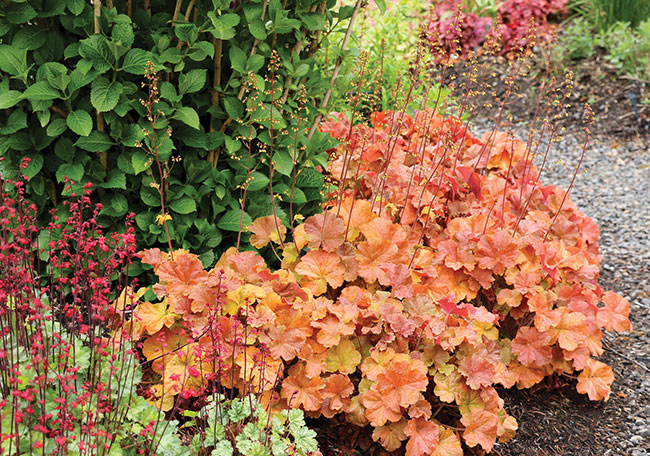 15. Northern Exposure Heuchera: To improve the hardiness of conventional Heuchera, Terra Nova searched high and low for untapped genetics in North America. “It’s native from the Arctic Circle down to the midwestern United States, so it has a huge range and varies a lot in hardiness, temperature and performance,” says Pavlich. They came across a hardy, but less esthetically pleasing variety from northern Saskatchewan, which was described as “leafy, green and hairy, with five-foot-tall flower stalks. Many generations later, the team managed to breed down the flower spike and introduced beautiful colours in an entirely new line without sacrificing hardiness. “They’ve had 100% survival in Zone 3 for two winters in a row.” Pavlich recommends getting the liners in February, then potting into 4” or a quart, followed by a gallon container. “They will likely start flowering in late May or early June,” he says, adding that the flowers, though less ornate, are attractive and appropriate for the plant’s size.
15. Northern Exposure Heuchera: To improve the hardiness of conventional Heuchera, Terra Nova searched high and low for untapped genetics in North America. “It’s native from the Arctic Circle down to the midwestern United States, so it has a huge range and varies a lot in hardiness, temperature and performance,” says Pavlich. They came across a hardy, but less esthetically pleasing variety from northern Saskatchewan, which was described as “leafy, green and hairy, with five-foot-tall flower stalks. Many generations later, the team managed to breed down the flower spike and introduced beautiful colours in an entirely new line without sacrificing hardiness. “They’ve had 100% survival in Zone 3 for two winters in a row.” Pavlich recommends getting the liners in February, then potting into 4” or a quart, followed by a gallon container. “They will likely start flowering in late May or early June,” he says, adding that the flowers, though less ornate, are attractive and appropriate for the plant’s size.
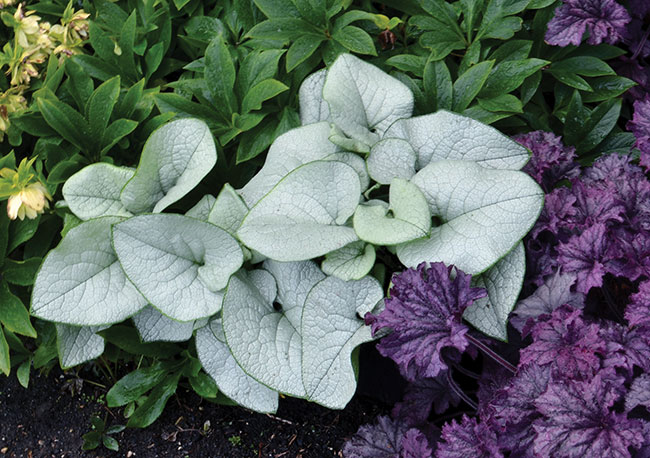 16. Brunnera Alexandria: A new selection for Terra Nova, the giant foliage of Alexandria comes from its parent, Alexandria the Great sourced from Belarus, Russia. Measuring 11” across, the beautiful heart-shaped leaves are silver over celadon in colour and reach full size by year two. “It’s phenomenal,” says Pavlich. “It reflects light like a mirror finish, but when you examine it up close, you can see that there’s celadon in the veining beneath the silver veil. It’s like growing moonlight in your garden.” Though rated for Zone 4, Pavlich surmises that Alexandria could be hardy to a colder climate. Finishes on the same schedule as Heucheras.
16. Brunnera Alexandria: A new selection for Terra Nova, the giant foliage of Alexandria comes from its parent, Alexandria the Great sourced from Belarus, Russia. Measuring 11” across, the beautiful heart-shaped leaves are silver over celadon in colour and reach full size by year two. “It’s phenomenal,” says Pavlich. “It reflects light like a mirror finish, but when you examine it up close, you can see that there’s celadon in the veining beneath the silver veil. It’s like growing moonlight in your garden.” Though rated for Zone 4, Pavlich surmises that Alexandria could be hardy to a colder climate. Finishes on the same schedule as Heucheras.
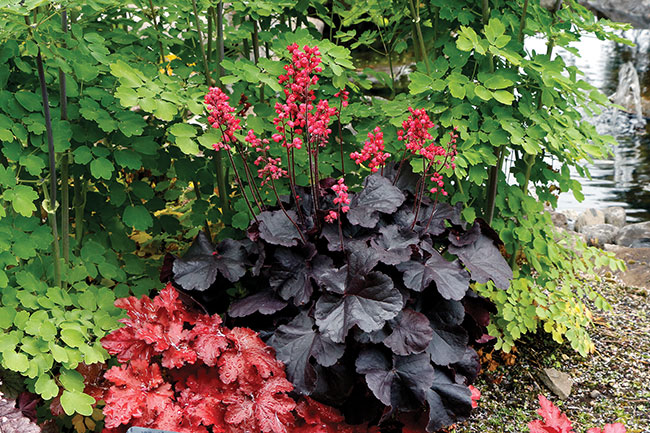 17. Heuchera Black Forest Cake: Offering exceptionally large cherry red flowers on top of chocolate black foliage, it’s not hard to see how new Black Forest Cake was named. “It’s just delish,” says Pavlich. “It’s cholesterol-free and bottomless, too.” Perfect for containers and garden beds, the medium-sized plant competes with Obsidian, Terra Nova’s other widely popular black Heuchera. Black Forest Cake flowers around end of May through October in the Portland, Oregon area, which may translate into a slightly later and more narrow period for parts of Canada from spring through frost. Zone 4.
17. Heuchera Black Forest Cake: Offering exceptionally large cherry red flowers on top of chocolate black foliage, it’s not hard to see how new Black Forest Cake was named. “It’s just delish,” says Pavlich. “It’s cholesterol-free and bottomless, too.” Perfect for containers and garden beds, the medium-sized plant competes with Obsidian, Terra Nova’s other widely popular black Heuchera. Black Forest Cake flowers around end of May through October in the Portland, Oregon area, which may translate into a slightly later and more narrow period for parts of Canada from spring through frost. Zone 4.
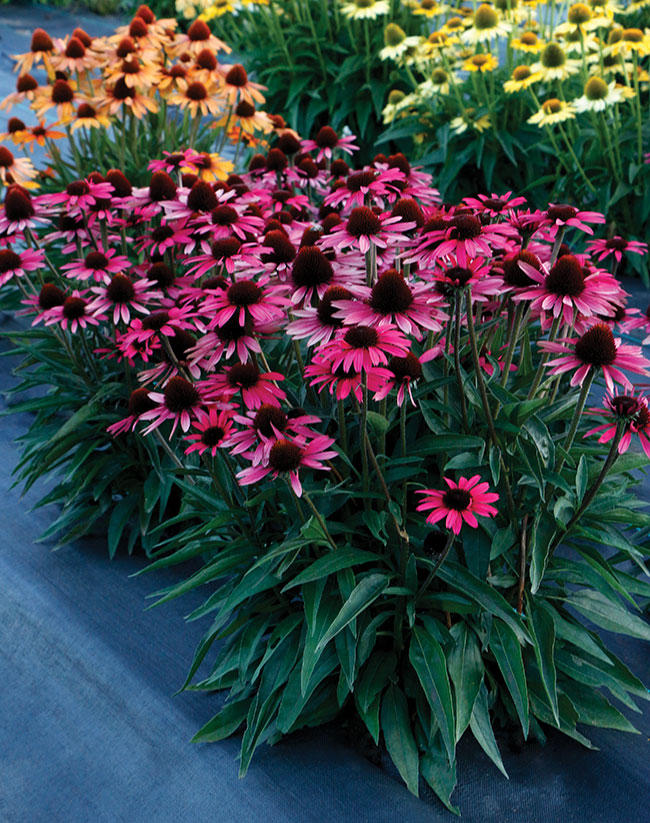 18. Echinacea Dark Shadows Wicked: Named for the sharp, eye-catching contrast of dark burgundy stems and cones against pine green foliage, the new Dark Shadows series debuts with Wicked’s electric pink flowers. “We actually stopped introducing echinaceas for a while and then re-tooled our breeding,” reveals Pavlich. Three years later, Terra Nova returned with high cone-producing echinacea with tidier habits. While echinaceas tend to be mid-border or background plants, this Zone 4 dwarfed series has foliage clear to the ground, making it a great choice for both containers and landscape. “They’ll be in bloom year 1, which is super important for containerized echinacea,” says Pavlich. “Bring them in for February and grow them up. Another way is to purchase them in September, bulk them over the winter and you can force them a little early. They’ll pop into flower sometimes as early as May.”
18. Echinacea Dark Shadows Wicked: Named for the sharp, eye-catching contrast of dark burgundy stems and cones against pine green foliage, the new Dark Shadows series debuts with Wicked’s electric pink flowers. “We actually stopped introducing echinaceas for a while and then re-tooled our breeding,” reveals Pavlich. Three years later, Terra Nova returned with high cone-producing echinacea with tidier habits. While echinaceas tend to be mid-border or background plants, this Zone 4 dwarfed series has foliage clear to the ground, making it a great choice for both containers and landscape. “They’ll be in bloom year 1, which is super important for containerized echinacea,” says Pavlich. “Bring them in for February and grow them up. Another way is to purchase them in September, bulk them over the winter and you can force them a little early. They’ll pop into flower sometimes as early as May.”
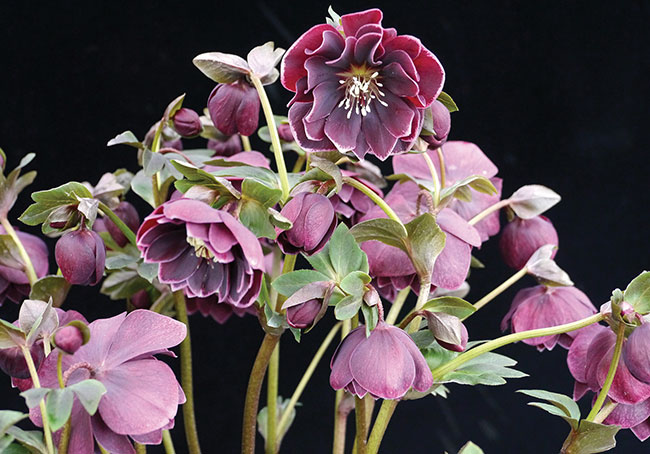 19. Helleborus North Star: “Hellebores are easy to grow from seed, but they’re not a true type and vary in their flowering time,” says Pavlich. After testing several iterations of different varieties from seed, Terra Nova selected ones that could produce large quantities without secreting phenolics, a substance produced by injured plants that eventually lead to their demise. “It took a long time to produce, and it’s a great series – super hardy,” he says of the Zone 4-rated North Star. “If you bring in our TC plants in June, grow them over the summer, bulk them, give them a rest, they’ll flower the very next spring – and that doesn’t happen in the seed-grown.” That means a saleable plant with flowers within nine months of receiving it. “It’s less expensive than buying the 30 cells.” Pavlich says there’s no variation among colours with the exception of North Star Plum (pictured), which grows just a little larger and taller than the other four offerings.
19. Helleborus North Star: “Hellebores are easy to grow from seed, but they’re not a true type and vary in their flowering time,” says Pavlich. After testing several iterations of different varieties from seed, Terra Nova selected ones that could produce large quantities without secreting phenolics, a substance produced by injured plants that eventually lead to their demise. “It took a long time to produce, and it’s a great series – super hardy,” he says of the Zone 4-rated North Star. “If you bring in our TC plants in June, grow them over the summer, bulk them, give them a rest, they’ll flower the very next spring – and that doesn’t happen in the seed-grown.” That means a saleable plant with flowers within nine months of receiving it. “It’s less expensive than buying the 30 cells.” Pavlich says there’s no variation among colours with the exception of North Star Plum (pictured), which grows just a little larger and taller than the other four offerings.
Danziger
Growers are more attuned to first-year flowering options these days, observes Lisa Heredia, marketing manager for Danziger in North America. It’s no surprise then, that the perennials in Danziger’s lineup are all first-year flowering. “The nice thing about first-year flowering is you get a more consistent crop. It’s more like an annual in that they all bloom together – same habit, same time,” she says, making it easier for picking and shipping later on. Having the flexibility can also be advantageous, allowing growers to fit in last-minute orders and capture extra sales opportunities.
Another trend she’s noticed is in repeat blooms and lasting colour, as opposed to one-and-done options. To ensure hardiness, all of her top perennial selections here have been trialled in Grand Rapids, Michigan, which is Zone 5.
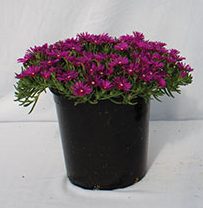 20. Early Bird Delosperma Cooperi: Though Delosperma cooperi has always been widely available, new genetics have taken flower coverage to a whole new level. “Not only have we bred for bigger and more flowers, but it’s also the first to open in the morning,” says Heredia. “That’s why we call it ‘Early Bird.’” The new series is available in a more compact pink, but the larger purple (pictured) offers a bit more versatility. “[The purple] can start as and make a showy quart, but it can grow into landscape a little faster, especially for the Canadian market.” And with a trend towards drought tolerance and rock gardening, this entry fits that niche perfectly.
20. Early Bird Delosperma Cooperi: Though Delosperma cooperi has always been widely available, new genetics have taken flower coverage to a whole new level. “Not only have we bred for bigger and more flowers, but it’s also the first to open in the morning,” says Heredia. “That’s why we call it ‘Early Bird.’” The new series is available in a more compact pink, but the larger purple (pictured) offers a bit more versatility. “[The purple] can start as and make a showy quart, but it can grow into landscape a little faster, especially for the Canadian market.” And with a trend towards drought tolerance and rock gardening, this entry fits that niche perfectly.
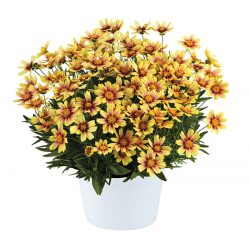 21. Solanna Coreopsis grandiflora – Sunset Burst, Sunshine: Adding to the self-cleaning Solanna series this year are five new colours and two in particular that will brighten up any day. “Sunset Burst (pictured) has been a real standout in trials,” says Heredia, who describes the look as strawberry lemonade, with a raspberry-type colour in the middle. Equally large in bloom and well-branched with prolonged flowering spring to fall, Sunshine offers a bold, bright yellow for a striking addition. “With our Coreopsis, we have found that they like to be grown cool…around 50ºF (10 ºC). You’re going to get a much heavier bloom set and a more consistent crop,” she says. But because no vernalization is required, growers can start sticking around January to February for a late spring to summer crop. Both are suitable for gallons or larger.
21. Solanna Coreopsis grandiflora – Sunset Burst, Sunshine: Adding to the self-cleaning Solanna series this year are five new colours and two in particular that will brighten up any day. “Sunset Burst (pictured) has been a real standout in trials,” says Heredia, who describes the look as strawberry lemonade, with a raspberry-type colour in the middle. Equally large in bloom and well-branched with prolonged flowering spring to fall, Sunshine offers a bold, bright yellow for a striking addition. “With our Coreopsis, we have found that they like to be grown cool…around 50ºF (10 ºC). You’re going to get a much heavier bloom set and a more consistent crop,” she says. But because no vernalization is required, growers can start sticking around January to February for a late spring to summer crop. Both are suitable for gallons or larger.
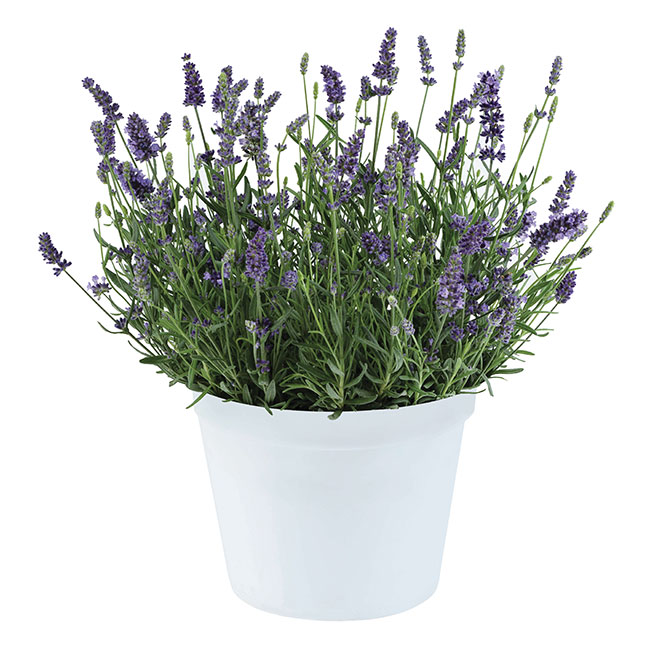 22. Layla Blue Lavender: This naturally compact Lavandula angustifolia needs no PGRs and finishes as a tidy little package in a quart or a gallon. “But unlike a lot of the other angustifolias that are compact, this one has a large bloom,” says Heredia. Based on trial results, she says the highly fragrant Layla Blue will be one of the earliest to bloom and will flower into the fall, but the habit stays compact, giving growers a finished product with minimal input.
22. Layla Blue Lavender: This naturally compact Lavandula angustifolia needs no PGRs and finishes as a tidy little package in a quart or a gallon. “But unlike a lot of the other angustifolias that are compact, this one has a large bloom,” says Heredia. Based on trial results, she says the highly fragrant Layla Blue will be one of the earliest to bloom and will flower into the fall, but the habit stays compact, giving growers a finished product with minimal input.
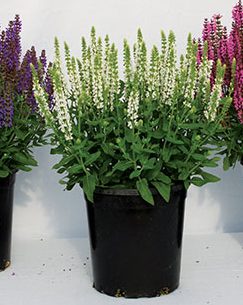 23. Apex White Salvia nemorosa: One of the most pollinator-friendly choices on Heredia’s list, Salvia Apex adds an elegant new white that is well-matched to its existing pink and blue varieties. “Sometimes nemorosas split in the middle when they get a little bigger, but we selected for habit,” she says. One of the first to flower in the spring, Apex reblooms over and over, continuously pushing out new buds for colour all summer-long. “It’s not a one-and-done like some of the older nemorosas on the market.”
23. Apex White Salvia nemorosa: One of the most pollinator-friendly choices on Heredia’s list, Salvia Apex adds an elegant new white that is well-matched to its existing pink and blue varieties. “Sometimes nemorosas split in the middle when they get a little bigger, but we selected for habit,” she says. One of the first to flower in the spring, Apex reblooms over and over, continuously pushing out new buds for colour all summer-long. “It’s not a one-and-done like some of the older nemorosas on the market.”
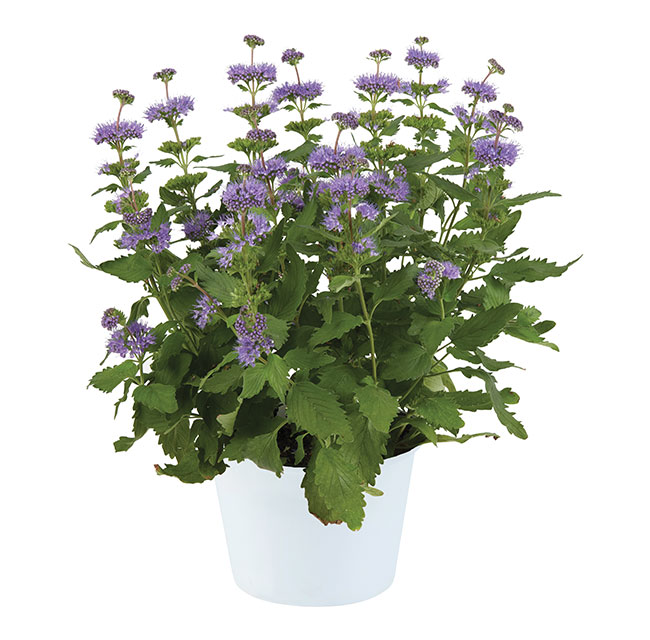 24. Pavilion Caryopteris – Blue, White: Though Caryopteris is typically produced as a shrub, Danziger released a dwarf version in pink a few years back. Perfect for smaller pot sizes, the breeder is now adding white and blue (pictured) to the series for 2021. Blooming late summer to early fall, the varieties produce little fuzzy balls of colour for garden enjoyment later in the season. “So when everything is tuckering out, these guys are just coming into their full glory,” says Heredia. Because of the timing, she says this crop tends to be passed over by growers, but that’s what makes it exciting. Die-hard gardeners love these, she says and the timing fits in just before and with the fall mum window.
24. Pavilion Caryopteris – Blue, White: Though Caryopteris is typically produced as a shrub, Danziger released a dwarf version in pink a few years back. Perfect for smaller pot sizes, the breeder is now adding white and blue (pictured) to the series for 2021. Blooming late summer to early fall, the varieties produce little fuzzy balls of colour for garden enjoyment later in the season. “So when everything is tuckering out, these guys are just coming into their full glory,” says Heredia. Because of the timing, she says this crop tends to be passed over by growers, but that’s what makes it exciting. Die-hard gardeners love these, she says and the timing fits in just before and with the fall mum window.
Jelitto Perennial Seeds
“The big trend in house plants (the introductory drug) will spill over to perennials at some point,” predicts Mary Vaananen, manager at Jelitto Perennial Seeds, “but one needs land for perennials.” With shrinking property sizes, Vaananen sees container perennials becoming more common, which in turn could mean greater demand for more compact plants from that segment of consumers.
“The trend towards naturalistic sustainable plantings – à la mini meadows and plant communities – continues to grow with the surge in wild/natural/ornamental public gardens all over the world,” she adds. “Gardeners always try to create what captures their sense of awe and beauty, even if in a much smaller space.” Those feelings of wonder and serenity couldn’t be more evident in the varieties she chose and the descriptions she wrote here.
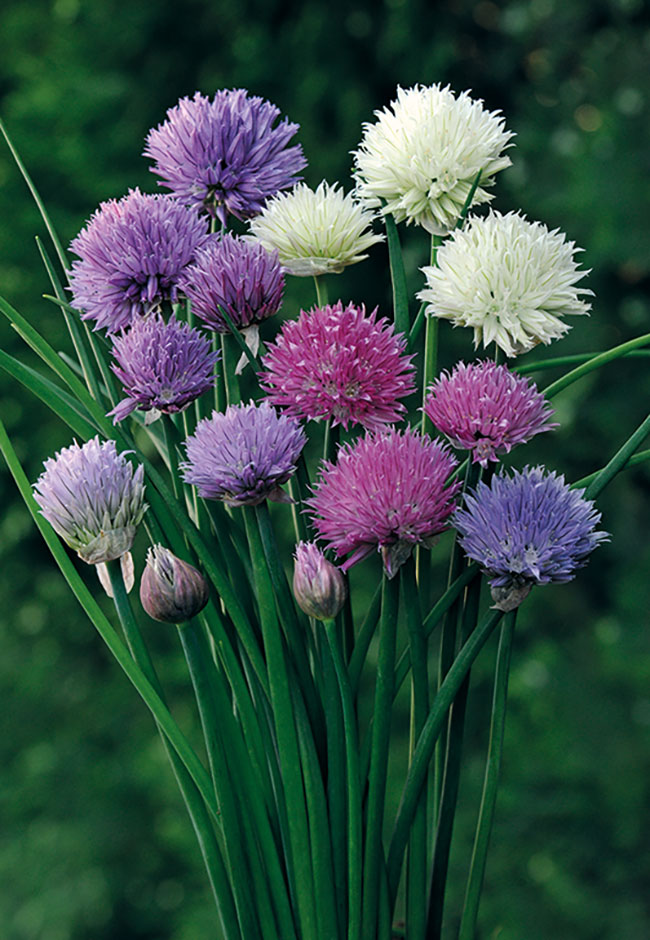 25. Allium schoenoprasum ‘Ornamental One’ series: Known as the common chive, Allium schoenoprasum is a well-known, useful and humble plant. Besides being grown for culinary uses, its drought tolerance has lent itself to green roof and wall applications. However, there is little use in an ornamental setting, likely because the ordinary chive lacks interesting flower colours. Focusing on multiple-use plants – namely edibles with ornamental qualities – Jelitto has introduced ‘The Ornamental One’ series of chives, debuting with the ‘Pink One,’ the ‘Purple One’ and the ‘White One.’ First-year flowering, deliciously edible and highly ornamental, all three colours are uniform in height and flowering time, complete with sturdy leaf blades and medium-sized foliage. Multi-use plants are very desirable these days – whether garden to table, garden to vase, en masse in garden settings or for use in container plantings. Sow around late winter for first-year flowers. Zone 3.
25. Allium schoenoprasum ‘Ornamental One’ series: Known as the common chive, Allium schoenoprasum is a well-known, useful and humble plant. Besides being grown for culinary uses, its drought tolerance has lent itself to green roof and wall applications. However, there is little use in an ornamental setting, likely because the ordinary chive lacks interesting flower colours. Focusing on multiple-use plants – namely edibles with ornamental qualities – Jelitto has introduced ‘The Ornamental One’ series of chives, debuting with the ‘Pink One,’ the ‘Purple One’ and the ‘White One.’ First-year flowering, deliciously edible and highly ornamental, all three colours are uniform in height and flowering time, complete with sturdy leaf blades and medium-sized foliage. Multi-use plants are very desirable these days – whether garden to table, garden to vase, en masse in garden settings or for use in container plantings. Sow around late winter for first-year flowers. Zone 3.
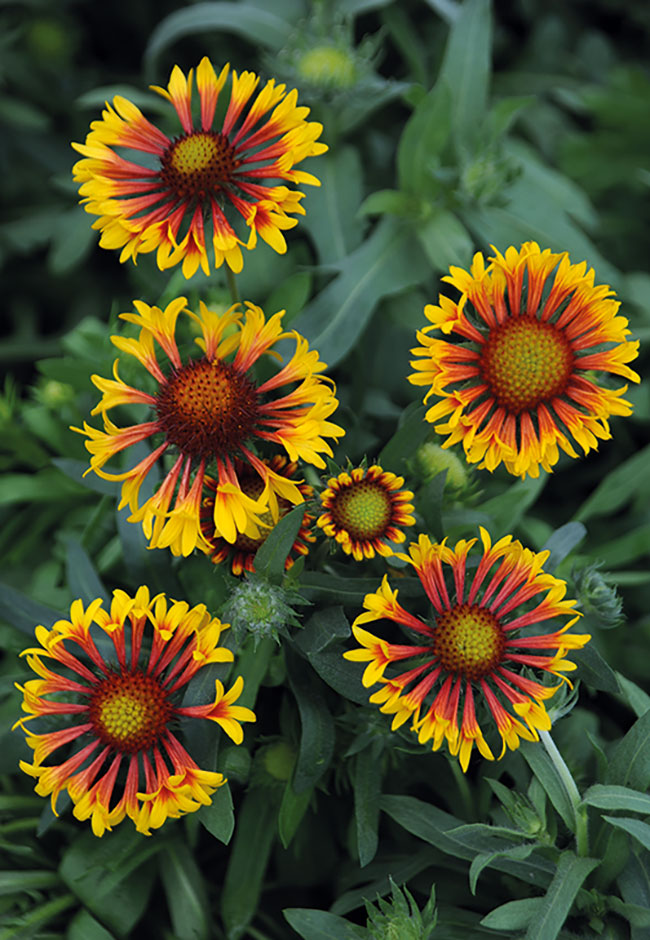 26. Gaillardia aristata ‘Fire Wheels’: Fire Wheels comes from a chance seedling found decades ago in the Jelitto production fields of the popular Gaillardia ‘Kobold.’ This new compact variety retains the tubular petals of Gaillardia ‘Fanfare,’ while showing a striking red with yellow tips. It has taken time to stabilize the fluted form, making sure the flowers are true to type and plants are hardy, vigorous and long lasting. Without patents or royalties to be paid, this easy-to-grow seed strain is also easy on the budget. Beautiful in the garden, ‘Fire Wheels’ drapes the front of the border in gold, orange and red hues from June through September. Sow in the winter for first-year flowers. Zone 3.
26. Gaillardia aristata ‘Fire Wheels’: Fire Wheels comes from a chance seedling found decades ago in the Jelitto production fields of the popular Gaillardia ‘Kobold.’ This new compact variety retains the tubular petals of Gaillardia ‘Fanfare,’ while showing a striking red with yellow tips. It has taken time to stabilize the fluted form, making sure the flowers are true to type and plants are hardy, vigorous and long lasting. Without patents or royalties to be paid, this easy-to-grow seed strain is also easy on the budget. Beautiful in the garden, ‘Fire Wheels’ drapes the front of the border in gold, orange and red hues from June through September. Sow in the winter for first-year flowers. Zone 3.
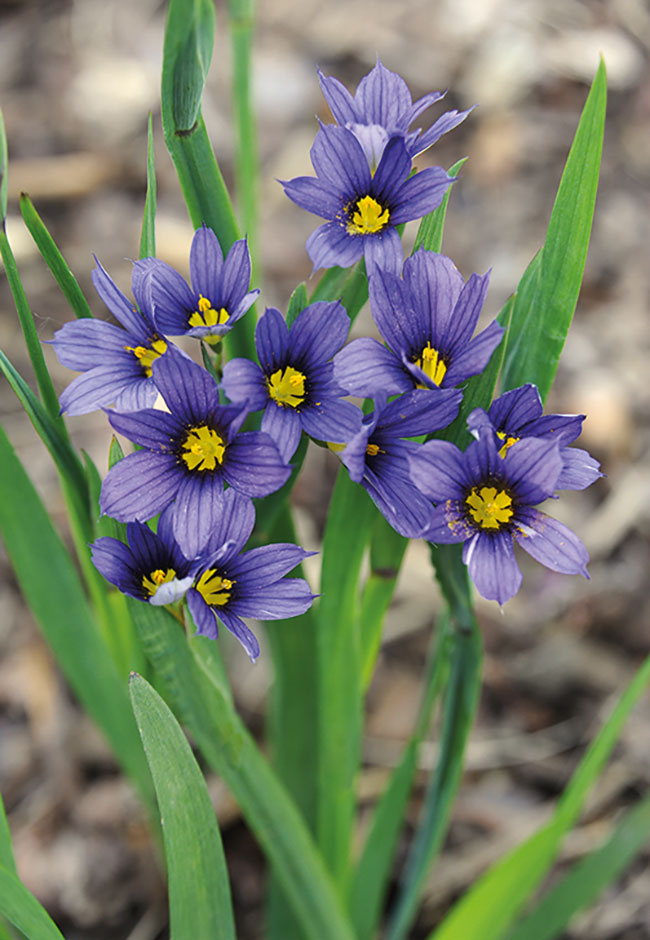 27. Sisyrinchium idahoense var. macounii ‘Moody Blues’: This beautiful blue-eyed member of the Iridaceae (Iris) family is smaller in stature than its relative S. angustifolium but larger in flower. A vigorous species of Idaho blue-eyed grass, Moody Blues grows naturally in moist open meadows. Flowering from May through July, the variety macounii is native to the Washington State and British Columbia regions, and named for John Macoun, an Irish-born Canadian naturalist and explorer of the Canadian prairies. Deep inky-blue centers surround bright golden sepals and petals of violet blue. These dramatic colours set the mood for delightful garden combinations whether planted in rockery, container, sunny garden bed or in the front of Prairie garden-like plantings. Reaching 4-5” tall and 6” wide, Moody Blues is a food source for multiple pollinators and beneficial insects. Sow in early spring for first-year flowers, or in the summer for an overwintering crop. Zone 4.
27. Sisyrinchium idahoense var. macounii ‘Moody Blues’: This beautiful blue-eyed member of the Iridaceae (Iris) family is smaller in stature than its relative S. angustifolium but larger in flower. A vigorous species of Idaho blue-eyed grass, Moody Blues grows naturally in moist open meadows. Flowering from May through July, the variety macounii is native to the Washington State and British Columbia regions, and named for John Macoun, an Irish-born Canadian naturalist and explorer of the Canadian prairies. Deep inky-blue centers surround bright golden sepals and petals of violet blue. These dramatic colours set the mood for delightful garden combinations whether planted in rockery, container, sunny garden bed or in the front of Prairie garden-like plantings. Reaching 4-5” tall and 6” wide, Moody Blues is a food source for multiple pollinators and beneficial insects. Sow in early spring for first-year flowers, or in the summer for an overwintering crop. Zone 4.
Proven Winners Perennials
“Pollinator plants continue to be a “buzz” word with consumers, particularly millennials who grew up hearing about this disappearance of bees,” says Andrew Jager, marketing specialist at Walters Gardens. “Another trend is perennials being selected for their foliage. Plants with dark, chartreuse, variegated, or colourful foliage all seem to be rising in popularity,” he adds. “I think this is borrowed from the houseplant market where a lot of the new millennial gardeners got their start.”
These trends are evident in the perennials selected by Jager, who wrote his descriptions here. From the silvery speckled leaves of Pulmonaria ‘Spot On’, to the pollinator-attracting Salvia ‘Color Spires,’ each one has its own appeal – whether to bees, hummingbirds or humans.
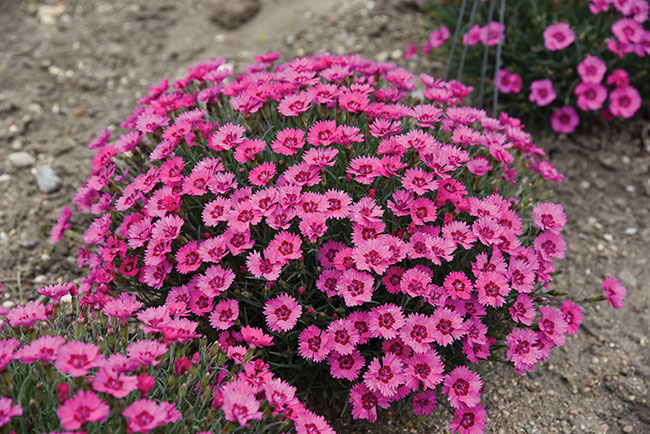 28. Dianthus ‘Paint the Town Fancy’: A new colour for the popular Paint the Town series of Dianthus from Proven Winners Perennials. ‘Paint the Town Fancy’ has notably large 1”, single, rosy fuchsia flowers and is the first variety in the collection with a red eye. This series blooms on average two weeks earlier than other Dianthus of its type, has exceptional rebloom, heat tolerance, hardiness, and vigour. 8-10” tall, 16-18” spread. Zone 4.
28. Dianthus ‘Paint the Town Fancy’: A new colour for the popular Paint the Town series of Dianthus from Proven Winners Perennials. ‘Paint the Town Fancy’ has notably large 1”, single, rosy fuchsia flowers and is the first variety in the collection with a red eye. This series blooms on average two weeks earlier than other Dianthus of its type, has exceptional rebloom, heat tolerance, hardiness, and vigour. 8-10” tall, 16-18” spread. Zone 4.
29. Phlox Luminary Collection: Tall garden phlox are a favourite in the garden, but often are plagued by powdery mildew in hot, humid conditions. These varieties are selected especially for their improved resistance over typical Phlox paniculata varieties. With beautiful colours and incredible performance, these are varieties to plant and watch grow, with little work required. Zone 3.
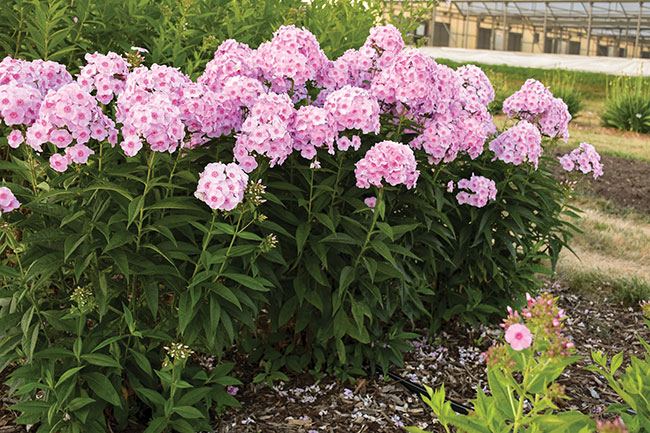
29a. Luminary Opalescence: The flagship variety of the LuminaryCollection and a new gold standard in powdery mildew resistance. In an extensive mildew trial, this was the very best variety to display resistance. Light pink flowers have dark pink eyes and are produced over dark green leaves; the darkest green we’ve seen on a Phlox paniculata. 30-32” tall, 24-28” spread.
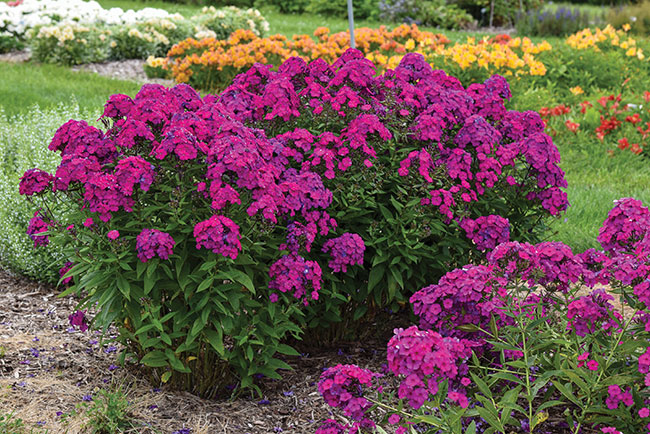
29b. Luminary Ultraviolet: Very dark, magenta violet flower panicles are held above a full, bushy habit of bright green foliage. An improvement on the industry standard ‘Nicky’, with darker stems and buds, bronzed leaves, more floriferous performance, and better resistance to powdery mildew. 32-36” tall, 28-32” spread.
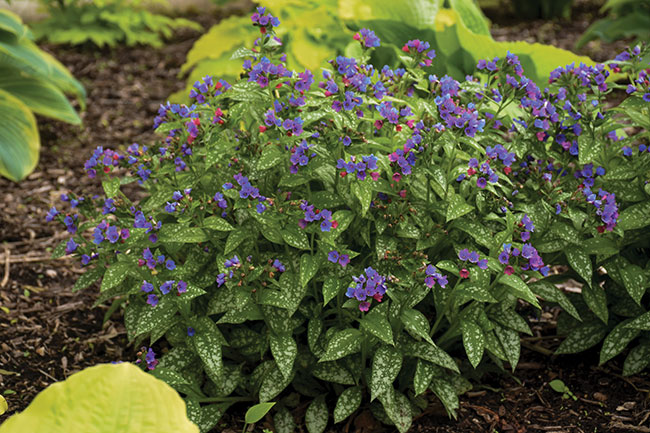 30. Pulmonaria ‘Spot On’: (Lungwort) ‘Spot On’ is a new Pulmonaria for Proven Winners, a new genus to the perennial lineup. Pulmonaria are the perfect choice to signal the end of winter with cheerful flowers appearing in late spring. The flowers of ‘Spot On’ open a unique deep salmon pink (nearly orange) that matures to a rich blue colour. Silver speckling dusts the green leaves. This is one of the first Pulmonaria to have near-orange flower buds. Use the speckled foliage as an accent for other shade plants after its bloom season. 14-16” tall, 18-20” spread. Zone 3.
30. Pulmonaria ‘Spot On’: (Lungwort) ‘Spot On’ is a new Pulmonaria for Proven Winners, a new genus to the perennial lineup. Pulmonaria are the perfect choice to signal the end of winter with cheerful flowers appearing in late spring. The flowers of ‘Spot On’ open a unique deep salmon pink (nearly orange) that matures to a rich blue colour. Silver speckling dusts the green leaves. This is one of the first Pulmonaria to have near-orange flower buds. Use the speckled foliage as an accent for other shade plants after its bloom season. 14-16” tall, 18-20” spread. Zone 3.
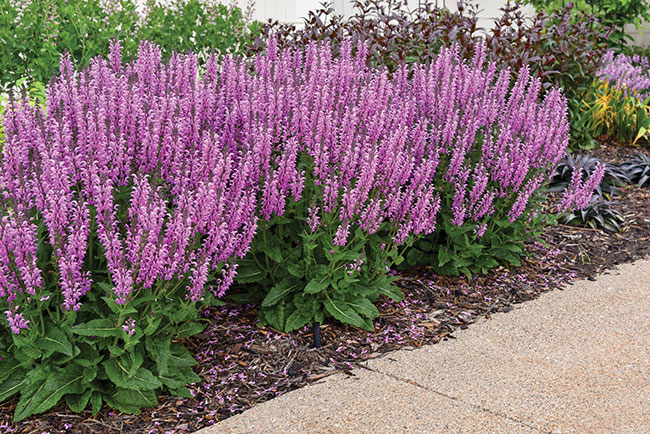 31. Salvia Color Spires ‘Back to the Fuchsia’: The darkest pink of the Color Spires Collection, this variety produces fuchsia pink flowers on dark charcoal stems. Flowers are produced prolifically above a canopy of dark green leaves. A cross between S. nemorosa and S. pratensis. Will rebloom if sheared back. 22-24” tall, 22-24” spread. Zone 3.
31. Salvia Color Spires ‘Back to the Fuchsia’: The darkest pink of the Color Spires Collection, this variety produces fuchsia pink flowers on dark charcoal stems. Flowers are produced prolifically above a canopy of dark green leaves. A cross between S. nemorosa and S. pratensis. Will rebloom if sheared back. 22-24” tall, 22-24” spread. Zone 3.
For Jager’s selected varieties, growers starting with 72ct trays (a small plug liner) should plant late summer to overwinter for sales the following year. If a grower is starting with 30ct trays (large plug) or bare root, they can be started in the spring for sales the same year. Depending on light, heat, and other growing conditions, large plugs/bare root can finish a container in about eight weeks.
Print this page